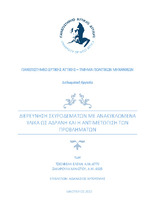| dc.contributor.advisor | Αυτουσμής, Αθανάσιος | |
| dc.contributor.author | Τζιούβελη, Ελένη | |
| dc.contributor.author | Χανιώτου, Ζαχαρούλα | |
| dc.date.accessioned | 2022-06-27T08:31:59Z | |
| dc.date.available | 2022-06-27T08:31:59Z | |
| dc.date.issued | 2022-02 | |
| dc.identifier.uri | https://polynoe.lib.uniwa.gr/xmlui/handle/11400/2362 | |
| dc.identifier.uri | http://dx.doi.org/10.26265/polynoe-2213 | |
| dc.description.abstract | Τα απόβλητα εκσκαφών, κατασκευών και κατεδαφίσεων (ΑΕΚΚ) φαίνονται να αποτελούν τα σημαντικότερα και μεγαλύτερα σε όγκο ρεύματα απορριμμάτων. Τα ΑΕΚΚ στην Ευρώπη αντιπροσωπεύουν το 25%-30% του συνόλου των αποβλήτων
καθώς επίσης η κατασκευαστική βιομηχανία, από την οποία προέρχονται, υπάγεται στις μεγαλύτερες παγκοσμίως καταναλωτές πρώτων υλών. Τα υλικά αυτά περιλαμβάνουν ύλες όπως π.χ σκυρόδεμα, κεραμικά, γύψος, ξύλο κ.λπ., εκ των οποίων
τα περισσότερα είναι δυνατό και αναγκαίο να επαναχρησιμοποιηθούν ή/και να ανακυκλωθούν, καθώς αποτελούν μη ανανεώσιμες πηγές. Η αναπάντεχη εξαγωγή και χρήση αδρανών υλικών που χρησιμοποιούνται για την παραγωγή οικοδομικών υλικών
και η μετέπειτα απόρριψή τους αποτελεί μείζον περιβαλλοντικό ζήτημα. Είναι λοιπόν, επιτακτική η ανάγκη να ληφθούν οι απαραίτητες ενέργειες για την επίλυση αυτού του προβλήματος εξετάζοντας λεπτομερώς τις δυνατότητες επαναχρησιμοποίησης και ανακύκλωσης των ΑΕΚΚ. Υπάρχουν στόχοι που πρέπει να επιτευχθούν από όλα τα κράτη μέλη της ΕΕ, εκ των οποίων και η Ελλάδα. Θέμα της παρούσας διπλωματικής εργασίας είναι η ανακύκλωση αδρανών υλικών με σκοπό την παραγωγή νέου σκυροδέματος καθώς και η αντιμετώπιση των προβλημάτων που προκύπτουν. Συγκεκριμένα, μέσα από την εργασία αυτή επιδιώκεται η εμβάθυνση της ανάγκης για ανακύκλωση και ο ρόλος αυτής σε περιβαλλοντικό επίπεδο ώστε το τεράστιο ρεύμα των αποβλήτων να αποκτήσει μια πιο βέβαιη αντιμετώπιση. Στο πρώτο μέρος της εργασίας γίνεται μια εισαγωγή σχετικά με το ρεύμα των ΑΕΚΚ, αναλύοντας τα χαρακτηριστικά και τις κατηγορίες που το περιγράφουν. Το μεγαλύτερο όμως μέρος της διπλωματικής περιλαμβάνει την ανάλυση σκυροδέματος με τα εξής κατά σειρά ανακυκλωμένα αδρανή: σκυρόδεμα, ασφαλτικά υλικά, κεραμικά υλικά, γύψος, γυαλί, ξύλο, πετρώματα και πλαστικό. Δίνεται ιδιαίτερη έμφαση στην ανακύκλωση των παραπάνω αδρανών καθώς και πως επηρεάζουν τα χαρακτηριστικά και τις αντοχές του παραγόμενου σκυροδέματος. Παρουσιάζονται επίσης αναφορές από
έρευνες που έχουν διεξαχθεί όπου εστιάζουν στα προβλήματα του παραγόμενου σκυροδέματος από ανακυκλωμένα αδρανή, παρουσιάζοντας τρόπους αντιμετώπισης. Συνεχίζοντας, μέσα από την εργασία, προσπαθούμε να εστιάσουμε στη σύγκριση του
νέου σκυροδέματος από ανακυκλωμένα αδρανή με το παραδοσιακό σκυρόδεμα από φυσικά αδρανή σε μία προσπάθεια ανάδειξης των διαφορών τους. | el |
| dc.format.extent | 164 | el |
| dc.language.iso | el | el |
| dc.publisher | Πανεπιστήμιο Δυτικής Αττικής | el |
| dc.rights | Αναφορά Δημιουργού - Μη Εμπορική Χρήση - Παρόμοια Διανομή 4.0 Διεθνές | * |
| dc.rights | Attribution-NonCommercial-NoDerivatives 4.0 Διεθνές | * |
| dc.rights.uri | http://creativecommons.org/licenses/by-nc-nd/4.0/ | * |
| dc.subject | Ανακυκλωμένο σκυρόδεμα | el |
| dc.subject | Σκυρόδεμα | el |
| dc.subject | Αδρανή υλικά | el |
| dc.subject | Επαναχρησιμοποίηση | el |
| dc.subject | Απόβλητα εκσκαφών | el |
| dc.subject | Απόβλητα κατασκευών | el |
| dc.subject | Απόβλητα κατεδαφίσεων | el |
| dc.title | Διερεύνηση σκυροδεμάτων με ανακυκλωμένα υλικά ως αδρανή και η αντιμετώπιση των προβλημάτων | el |
| dc.title.alternative | Investigating concrete with recycled materials as aggregates and troubleshooting | el |
| dc.type | Διπλωματική εργασία | el |
| dc.contributor.committee | Δενεζάκη, Σταυρούλα | |
| dc.contributor.committee | Κόκκινος, Φίλης-Τριαντάφυλλος | |
| dc.contributor.faculty | Σχολή Μηχανικών | el |
| dc.contributor.department | Τμήμα Πολιτικών Μηχανικών | el |
| dc.description.abstracttranslated | Excavation, construction and demolition waste seems to be the most important and largest waste streams. Excavation, construction and demolition waste in Europe represents 25% -30% of all waste as well as the construction industry, from which they come, is one of the largest consumers of raw materials in the world. These materials include materials such as concrete, ceramics, plaster, wood, etc., most of which are possible and necessary to be reused or recycled, as they are non-renewable sources. The unexpected export and use of aggregates used in the production of building materials and their subsequent disposal is a major environmental issue. It is therefore imperative that the necessary steps be taken to resolve this problem by examining in detail the possibilities of reuse and recycling of Excavation, construction and demolition waste. There are goals to be achieved by all EU Member States, including Greece. The subject of this dissertation is the recycling of aggregates in order to produce new
concrete and to address the problems that arise. In particular, this work seeks to deepen the need for recycling and its role at the environmental level so that the huge stream of waste can be treated more confidently. In the first part of the work, an introduction is made about the current of Excavation, construction and demolition waste, analyzing the characteristics and the categories that
describe it. But most of the dissertation includes the analysis of concrete with the following in order recycled aggregates: concrete, asphalt materials, ceramic materials, plaster, glass, wood, rocks and plastic. Special emphasis is given to the recycling of the
above aggregates as well as how they affect the characteristics and strengths of the produced concrete. There are also reports from research that focuses on the problems of concrete produced from recycled aggregates, presenting ways to deal with it.
Continuing, through the work, we try to focus on the comparison of the new concrete from recycled aggregate with the traditional concrete from natural aggregate in an attempt to highlight their differences. | el |


